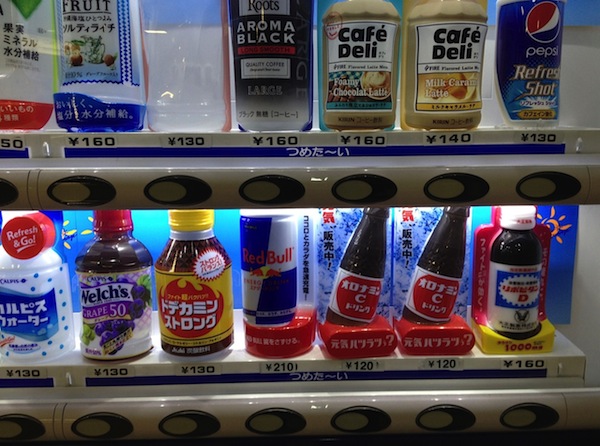Small Change Adds Up
 Wednesday, April 16, 2014 at 3:04PM
Wednesday, April 16, 2014 at 3:04PM
 I've been noticing small changes in the prices of everything lately. The prices of drinks sold from vending machines also went up yesterday.
I've been noticing small changes in the prices of everything lately. The prices of drinks sold from vending machines also went up yesterday.
A bottle of Oronamin C (bottom row, second from the right) cost ¥110 in the morning. By the afternoon, it was selling for ¥120. The price of a bottle of Ribobitan D (blue and white bottle at the bottom right) shot up, from ¥150 to ¥160.
As I put in an extra ten yen into the machine, I couldn't help feeling that the numbers weren't adding up.
If the price of a bottle of Oronamin C, excluding tax is roughly ¥105, the new price including 8% sales tax should be about ¥113 rather than ¥120.
Perhaps, the drink makers were taking into account that the consumption tax is going to be raised to 10% next year. Well, even with a 10% consumption tax, a bottle of Oronamin C would still cost only ¥115. What this means, of course, is that the vendors of Oronamin C are pocketing an extra seven yen in revenue for each bottle they sell through their machines.
The same is true for Ribobitan D. Before the consumption tax increase, a bottle cost ¥150. Today, ¥160.
The actual price of a bottle of the drink, excluding sales tax, comes to ¥143. With a sales tax of 8% a bottle should cost ¥154, not ¥160. Even with the sales tax doubled to 10% a bottle would sell for ¥157. So, with each bottle of Ribobitan D or similarly priced item, the distributor is making an extra six yen in revenue.
It seems that while many companies have balked at the idea of increasing the consumption tax, many of them are using this as an opportunity to bolster the bottom line.
Later . . .
A friend took issue with my claim that Japanese companies were using the tax hike to increase profits (I wrote "revenue", but profit was what I was really getting at), arguing that the vendors have been operating on "wafer thin margins" for years.
That got me thinking. Were these vending machine operators really just scraping by? If they were, I doubt for one that there would be so goddamn many vending machines out there. Anyone who visits Japan will be surprised by not only how ubiquitous drinks machines are, but by how well maintained, new, and increasingly high-tech the vending machines are. The companies are clearly earning enough money to put some of it back into developing or purchasing new "hardware" on a regular basis.
And what, I wondered, did a bottle of Oronamin C actually cost the distributor. Although O.C. now sells for ¥120 at most vending machines, I discovered that at one of the universities where I teach, O.C. was still selling for only ¥100. The local supermarket down the street sells bottles of the energy drink for as little as ¥84. At ¥84, the cost of a bottle of O.C. minus consumption tax is ¥77.3. Assuming that O.C. is not a loss leader and the supermarket has a flat profit margin of, say, 2-3% on all of its products like Costco, then a bottle of Oronamin C really costs about ¥74. Or possibly even less than that. (A can of Dr. Pepper at Costco, for instance, only costs about ¥60 per can if you buy a case of 24.)
I also looked into Otsuka, the maker of Oronamin C, to see how many bottles of the energy drink it produces every year. Would you believe that 25 BILLION bottles of the stuff was consumed in 2000 (the latest year for which I could find reliable stats)? With production levels so high, I doubt the pharmaceutical company and the distributors who sell its products are hurting all that much. A company that big and profitable probably knows what it's doing.
